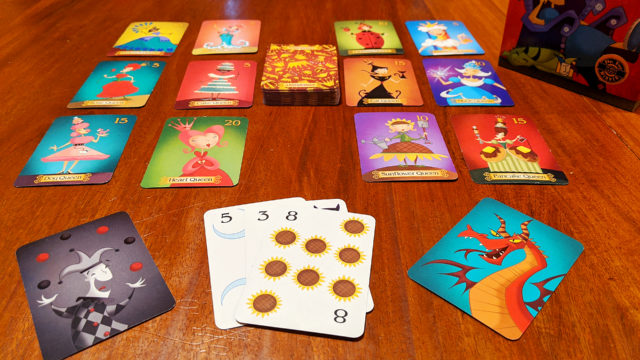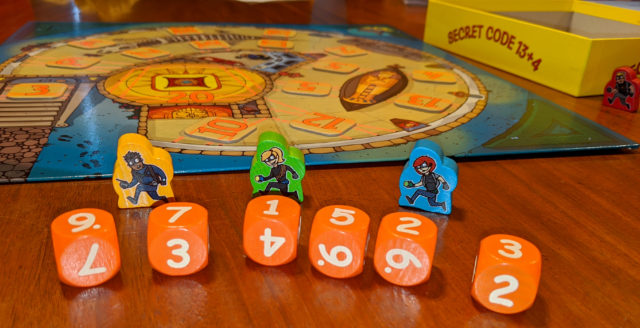Like many parents fortunate enough to be or work at home right now, I am wrestling with how to homeschool my kids. I have a kindergartener and a preschooler, so the stakes are low but the hours are long. It has taken a while for our school district to establish distance learning, so we don’t really have a curriculum–just a vague idea that every day, our kindergartener should be reading, writing, and arithmetic-ing.
We printed some online worksheets, tried reading some phonics books, attempted some sticker books. Getting her to do these activities was like trying to pull the wiggly tooth out of her mouth: she fought them.
So we played games, because, well, we own a board game store that isn’t allowed to operate right now, so we’re putting our inventory to good use. We brought home Sleeping Queens, which asked us to build equations. “Equations?” my spouse said, thinking this game would be too hard.
“Number sentences!” I said happily. “Like 3 + 1 = 4. Or 5 + 6 = 11. Number sentences.”
And just like that, I switched my tune. No more worksheets. We’re going to board game our way through this quarantine homeschool.*
Here are what we’ve found for elementary math:
Sleeping Queens

Designed by a six-year-old and her family, Sleeping Queens is a card game where you’re trying to collect five of twelve queens who are “sleeping” face down in the middle of the table. Each queen also has a numerical value, so the end goal is either five queens or queens that equal 50 points.
You can collect a queen from the middle by playing a king; capture a queen from another player with a knight; or put someone else’s queen to sleep with a sleeping draught. The attack cards have antidotes as well (a dragon to fend off the knight; a magic wand to counteract the sleeping draught). All of the kings and queens have special names, like Cupcake Queen or Tie-Dye King, and the artwork matches the cute names.
Here’s the math part: most of the cards in the deck are not special–they’re just numbers 1-10. Your strategy is to sift through the deck to find the special cards by discarding as many number cards as you can. You can always discard a single card, but that’s slow going. You may discard two cards by finding a pair of numbers. But what you really want are number sentences.

If you can make a number sentence of three or four cards, you may discard all of the cards in the equation and pick up just as many. So if I were to have two 5s and a 10, I’d make a number sentence of three cards: “5 + 5 = 10.” I could discard four cards if I had an equation like “3 + 4 + 1 = 8.” The game works with addition only.
Our kindergartener didn’t play any number sentences the first game, and when we challenged her on the second, she came up with one. Now she’s playing more, and it’s exciting to watch her mind think. I love, too, that it was designed by a family.
Secret Code: 9 + 4 = 13
If Sleeping Queens is math in stealthy disguise, Secret Code is math in flamboyant costume. The board for Secret Code is shaped as a large circle decoder with numbers around it; the numbers are cardboard chits randomized for each game, creating a different board each time.

During a turn, a player rolls six six-sided dice. (Three of the dice have regular 1-6 sides; the other three have 4-9 sides.) The player then has to make a number sentence that equals the number on the board. So, for example, if the number on the next space is 2, the player would choose dice two numbers apart, like 6 & 4 or 8 & 6. Technically, the official rules would allow a player to discard a die with a 2 on it to equal the 2 space, but we’re not playing with that rule to encourage finding number sentences.
The math in Secret Code is significantly more advanced than Sleeping Queens in a number of ways. First, the board numbers go all the way up to 20, so there are more options for the variety of equations you might have. Second, you can use subtraction as well (like “6 – 4 = 2”). Third, there is an advanced version that would allow for multiplication and division, making this game also applicable for higher grades than kindergarten.

Much of how well you do in the game depends on the dice, which is a nice equalizing factor for players of different abilities. By rolling six dice, you can–theoretically–get past three numbers on the board. An average roll gets you past two numbers. A bad roll gets you past one number. Today, I had several bad rolls in this game, and my kindergartener creamed me–much to her extreme delight.
For teaching math in a quarantine, I’ll take this game over worksheets any day.
(Bonus shout-out for Secret Code: Haba, its publisher, is selling games direct to customers from its website. If you mention your favorite local friendly game store in the comments, Haba will give them a percentage of the sale!)
What About Your Game-School?
What are you playing with your kids right now? Share your board game homeschooling adventures in the comments below.
*I am not the first to have this idea! Shout out to Ryan Sanders, founder of the site Adventures in Gameschooling, for writing a wealth of material on game-based learning. I found his site only recently and am excited to dive in for more ideas.
Comments
No comments yet! Be the first!